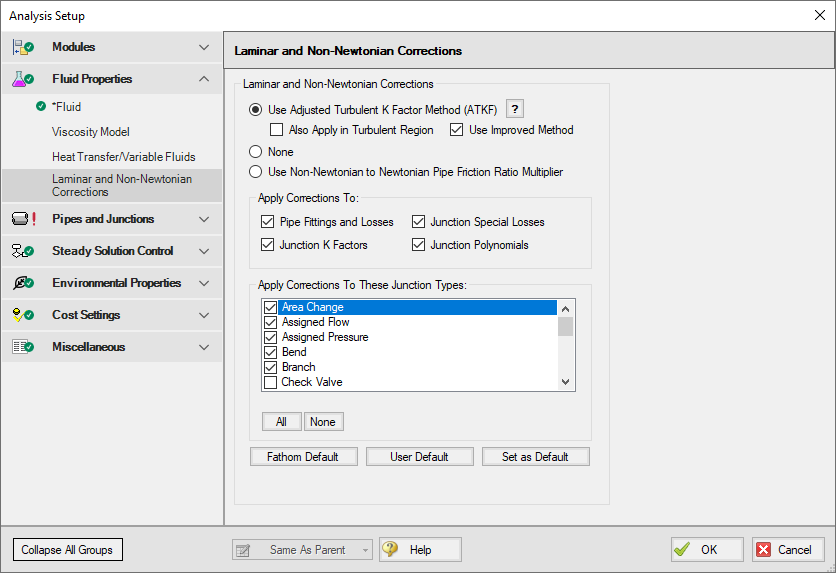Laminar and Non-Newtonian Corrections Panel
AFT Fathom uses the methods and correlations discussed for each viscosity model only to model frictional losses for pipes. Frictional losses due to pipe fittings or junction losses are modeled using the methods discussed on this page regardless of viscosity model.
It is generally believed that the pressure drop through valves, fittings, etc. derive from bulk fluid motion, wall separation, turbulence, etc. and hence are not affected by non-Newtonian fluid behavior in turbulent flow. Thus, pressure loss due to pipe fittings or junction-specific losses during turbulent flow are modeled using the same methods employed for Newtonian flow.
During laminar flow those losses may not be similar for both Newtonian and non-Newtonian fluids. AFT Fathom offers three options to model the losses due to pipe fittings or junctions during laminar flow. They are:
-
Use Adjusted Turbulent K Factor Method (ATKF) (selected by default) - derived from the Crane hydraulic handbook (Crane 1988Crane Co., Flow of Fluids Through Valves, Fittings, and Pipe, Technical Paper No. 410, Crane Co., Joliet, IL, 1988. ).
-
Also Apply in Turbulent Region
-
Use Improved Method (checked by default)
-
-
None
-
Use Non-Newtonian to Newtonian Pipe Friction Ratio Multiplier
Modifying Losses for Fittings and Junctions Interface
The options listed above to modify losses at fittings and junctions can be found on the Laminar and Non-Newtonian Corrections panel in the Fluids Properties group of the Analysis Setup, as shown in Figure 1 below.

Figure 1: Options to modify fitting and junction losses on the Laminar and Non-Newtonian Corrections panel
Users must select which of the three options they wish to use. They must also select which non-pipe losses to apply the corrections to.
Non-Newtonian to Newtonian Pipe Friction Ratio
One approach to modeling losses associated with fittings and junction losses is to assume that the ratio of those losses in a non-Newtonian and Newtonian fluid is equivalent to the ratio of pipe friction in a non-Newtonian and Newtonian fluid. One can write:
This approach uses the pipe friction at the adjacent upstream pipe and the uncorrected loss factor in a Newtonian fluid to model the losses associated with the fitting or junction for a non-Newtonian fluid.
Related Topics
Heat Transfer/Variable Fluids Panel
SSL Module Fluid Properties Group
Adjusted Turbulent K Factor Method (ATKF)
Related Blogs
Applying the Improved ATKF Method for Laminar and Non-Newtonian Flow



